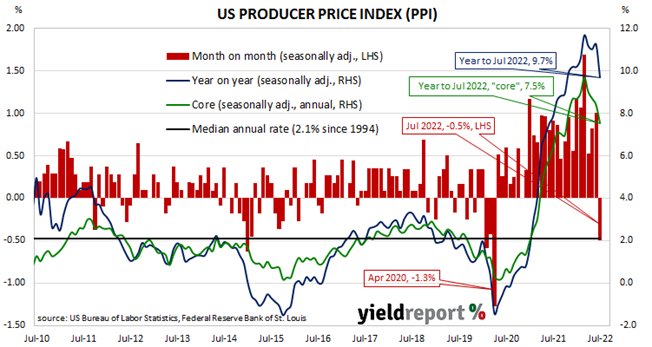Summary: US producer price index (PPI) down 0.5% in July, less than expected figure; annual rate slows to 9.7%; “core” PPI up 0.2%; fuel accounts for 80% of decline; longer-term US Treasury yields considerably higher, rate-rise expectations firm.
Around the end of 2018, the annual inflation rate of the US producer price index (PPI) began a downtrend which continued through 2019. Months in which producer prices increased suggested the trend may have been coming to an end, only for it to continue, culminating in a plunge in April 2020. Figures returned to “normal” towards the end of that year but annual rates over the past eighteen months have been well above the long-term average.
The latest figures published by the Bureau of Labor Statistics indicate producer prices fell by 0.5% after seasonal adjustments in July. The decline was in contrast with the 0.3% increase which had been generally expected as well as June’s revised increase of 1.0%. On a 12-month basis, the rate of producer price inflation after seasonal adjustments slowed from 11.2% in June to 9.7%.
Producer prices excluding foods and energy, or “core” PPI, rose by 0.2% after seasonal adjustments. The increase was half the 0.4% rise that had been generally expected as well as June’s 0.4%. The annual rate slowed from June’s revised figure of 8.4% to 7.5%.
“The drop in fuel prices accounted for 80% of the decline in prices in July,” said ANZ economist Kishti Sen. “Food prices also eased 0.9%. Easing supply chain pressures appear to be the main factor driving the moderation of prices.”
Long-term US Treasury bond yields moved considerably higher on the day. By the close of business, the 10-year Treasury yield had gained 10bps to 2.89% and the 30-year yield had increased by 15bps to 3.18%. The 2-year yield finished 2bp lower at 3.19%.
In terms of US Fed policy, expectations of a steeper path for the federal funds rate over the next 12 months firmed. At the close of business, September contracts implied an effective federal funds rate of 2.52%, 19bps higher than the current spot rate. November contracts implied 3.31% while September 2023 futures contracts implied an effective federal funds rate of 3.425%, about 110bps above the spot rate.
The producer price index is a measure of prices received by producers for domestically produced goods, services and construction. It is put together in a fashion similar to the consumer price index (CPI) except it measures prices received from the producer’s perspective rather than from the perspective of a retailer or a consumer. It is another one of the various measures of inflation tracked by the US Fed, along with core personal consumption expenditure (PCE) price data.


